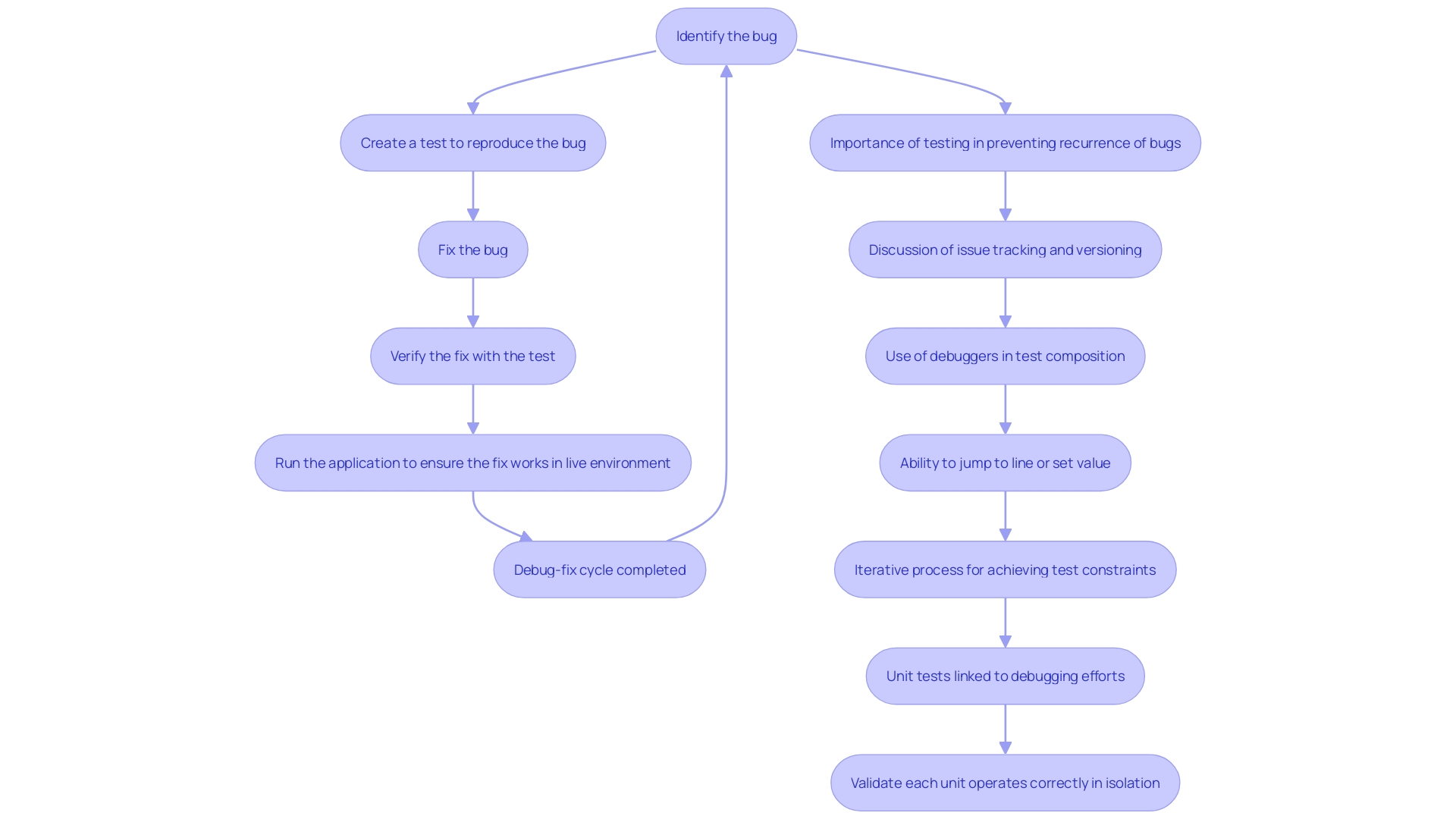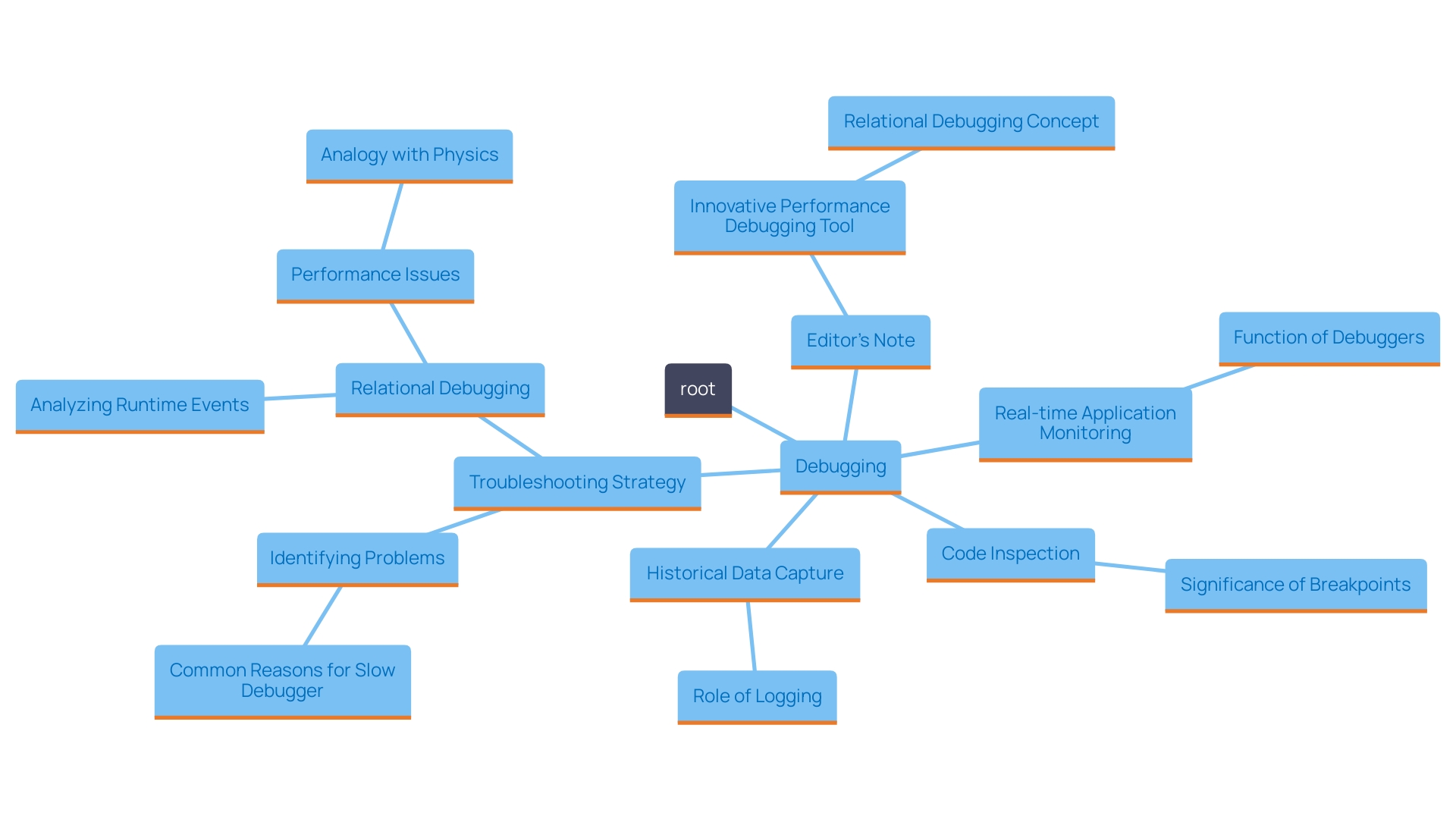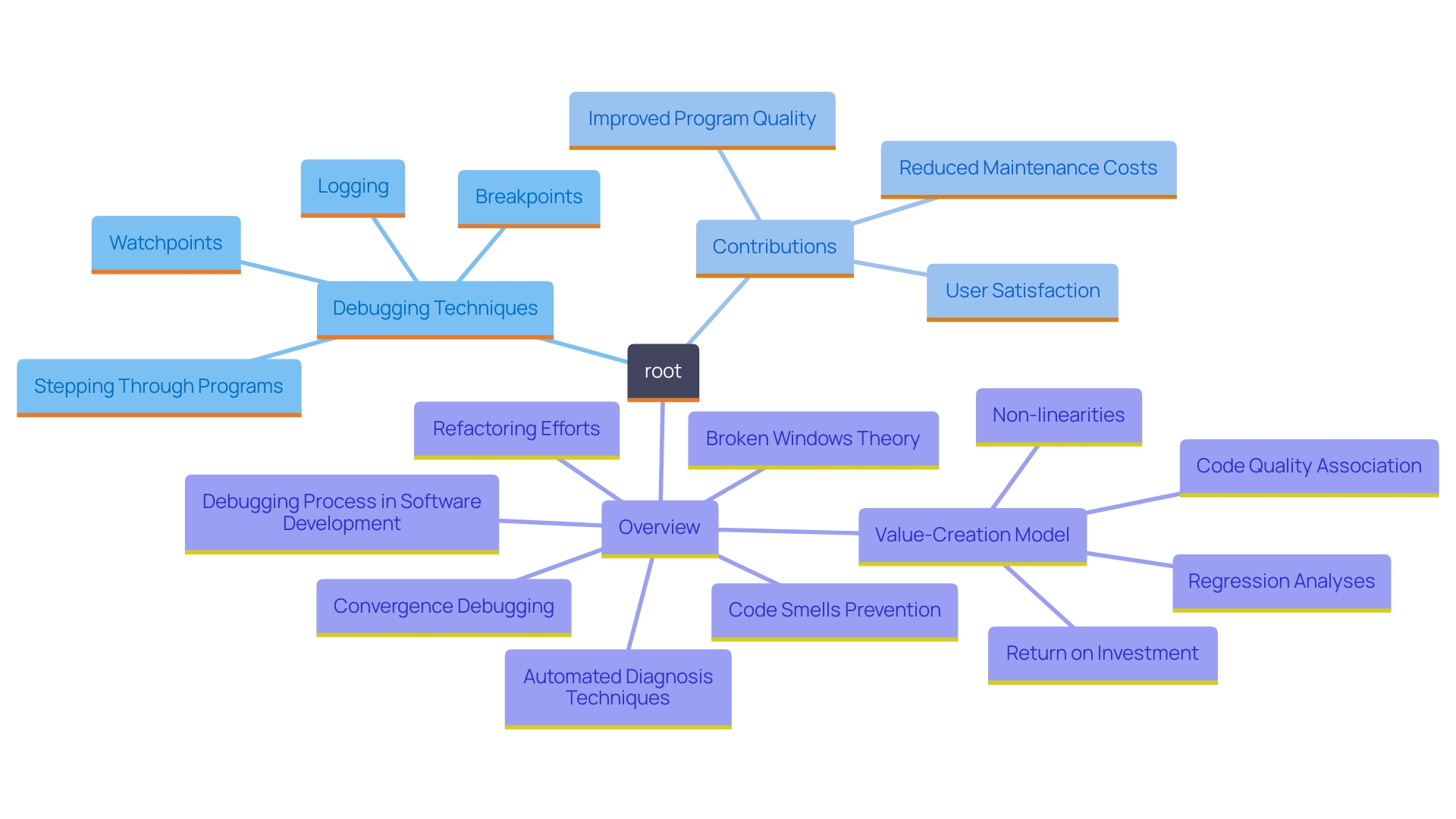Introduction
In the realm of software development, the ability to efficiently identify and resolve bugs is paramount. Debuggers emerge as essential allies in this pursuit, empowering developers to dissect their code with precision and clarity. By providing tools to set breakpoints and step through execution, these powerful programs enable a deeper understanding of application behavior, transforming the often daunting debugging process into a more manageable and insightful experience.
As development methodologies evolve, particularly with the rise of Test Driven Development (TDD), the role of debuggers becomes increasingly critical, ensuring that code not only meets predefined tests but also operates reliably in real-world scenarios. With the integration of advanced debugging techniques and logging frameworks, developers are better equipped to tackle complex issues, ultimately leading to enhanced software quality and user satisfaction.
Defining a Debugger
A debugger acts as a crucial instrument in a programmer's collection, intended to examine and control the operation of scripts with accuracy. This powerful software enables programmers to set breakpoints strategically, allowing them to pause operation at key points and observe the flow of control. By stepping through the program line by line, developers can scrutinize variable values at various execution stages, gaining insights into how their work behaves in real time. This capability is particularly crucial in the context of methodologies like Test Driven Development (TDD), where tests are written prior to the programming itself, guiding the development process. The debugger becomes a crucial ally in ensuring that the program meets the specified tests, facilitating the identification of logical errors and bugs efficiently. The capability to track the process flow and observe variable states improves the programmer's comprehension of the code, enabling quicker resolutions of problems and ultimately resulting in a more robust and dependable software product. As the community continues to focus on enhancing debugging experiences, the tools available are evolving to support seamless debugging, even in complex asynchronous environments, ensuring that programmers can tackle challenges with confidence.

How Debuggers Work
Debuggers are indispensable tools in software development, enhancing the process of identifying and resolving bugs. They operate by connecting to a running application, forming a regulated setting that permits programmers to observe its operation in real-time. When a breakpoint is activated, the debugger halts the program, providing a unique opportunity for programmers to inspect the current state comprehensively. This includes examining memory allocation, analyzing variable values, and tracing control flow, which are crucial for diagnosing issues that arise during execution.
The ability to step through code line-by-line is one of the standout features of integrated debuggers, enabling programmers to pinpoint the exact moment a bug occurs. Breakpoints serve as strategic pause points, allowing for deep inspection at critical junctures in the application’s flow. This meticulous attention to detail is especially essential when dealing with complex bugs that can stem from logical errors or unexpected interactions within the codebase.
Moreover, logging plays a vital role in the troubleshooting process, particularly for applications in production. It provides a historical context for events, making it easier to trace issues that may not manifest during local testing. By capturing errors and application behavior over time, logging frameworks enable programmers to gain insights into user-reported issues, even when they cannot replicate them in their own environments. This combination of debugging and logging not only enhances the debugging process but also contributes significantly to overall application performance monitoring, enabling programmers to identify bottlenecks and optimize operations effectively.

The Importance of Debuggers in Coding
Debuggers are indispensable tools in the software development lifecycle, providing critical support for enhancing software quality and expediting the development process. By enabling programmers to efficiently identify and resolve defects before deployment, debuggers significantly mitigate the risk of bugs making their way into production environments. These tools promote a setting where developers can swiftly iterate on their work, receiving immediate feedback and insights into application behavior. This capability not only accelerates the development timeline but also enhances overall system health, which is essential in maintaining sustainable software solutions.
Moreover, effective troubleshooting strategies often require a systematic approach that combines various tools and methodologies. Integrated debuggers, for example, provide a comprehensive method of tracking code execution and inspecting variable states, while logging frameworks enable a historical record of events that assists programmers in troubleshooting issues in real-time, particularly in production environments. By effectively utilizing logging, programmers can track errors, monitor application performance, and gain insights into user-reported issues, thus enabling a proactive approach to problem-solving.
In recent discussions within the developer community, there has been a notable shift towards adopting advanced troubleshooting tools that enhance inner-loop productivity. Ongoing enhancements in these tools have concentrated on rendering troubleshooting experiences more user-friendly and efficient. As organizations increasingly prioritize performance testing and shift-left testing strategies, the role of debuggers becomes even more crucial. This trend signifies a collective acknowledgment that while encountering bugs is an inevitable part of software development, the right troubleshooting techniques can lead to more robust applications and a smoother overall development process.

Common Debugging Techniques
Debugging is a crucial and multifaceted element of the software development lifecycle (SDLC), significantly affecting program quality, user satisfaction, and maintenance costs. Several techniques can streamline the debugging process, including breakpoints, stepping through programs, watchpoints, and logging.
- Breakpoints are effective instruments that enable programmers to halt processing at particular lines of script. This enables them to inspect the current state of the application and understand how data is being manipulated at that exact moment.
- Stepping through the program lets developers execute their instructions line by line. This granular method aids in detecting logic errors and variable misassignments by providing a detailed perspective of code operation flow.
- Watchpoints serve to monitor specific variables for changes, facilitating the identification of when and why unexpected values appear. This proactive observation of variables can significantly reduce debugging time.
- Logging offers a comprehensive historical record of execution, which can be invaluable for post-mortem analysis. Unlike simple print statements, logging provides a structured way to capture and categorize events, making it easier to understand the sequence of operations leading to a bug. This method enables programmers to monitor recurring issues and patterns over time, contributing to enhanced code quality.
Incorporating these techniques effectively can lead to an enhanced user experience, as fewer bugs result in higher satisfaction and retention rates. Additionally, consistent debugging practices not only lower maintenance costs by catching issues early but also foster a culture of quality within development teams. By mastering these techniques, developers can navigate the complex landscape of modern software development with greater confidence and efficiency.

Conclusion
The role of debuggers in the software development process cannot be overstated. They serve as vital tools that enhance the ability of developers to identify and resolve bugs efficiently, ultimately leading to higher quality software. By utilizing features such as breakpoints, stepping through code, watchpoints, and logging, developers can gain a comprehensive understanding of their code's behavior.
This meticulous approach to debugging allows for quicker identification of logical errors and unexpected interactions, which is essential in today’s complex coding environments.
Furthermore, the integration of advanced debugging techniques within methodologies like Test Driven Development (TDD) emphasizes the importance of ensuring that code meets predefined tests and operates reliably. As developers adopt these strategies, they not only streamline their workflow but also contribute to a culture of quality within their teams. The continuous evolution of debugging tools reflects a collective commitment to improving inner-loop productivity and application performance, positioning debuggers as indispensable allies in the quest for robust software solutions.
In conclusion, embracing effective debugging practices is crucial for achieving maximum efficiency and productivity in software development. By prioritizing these techniques, developers can navigate challenges with confidence, reduce maintenance costs, and ultimately deliver a superior user experience. As the landscape of software development continues to evolve, the power of debuggers will remain a cornerstone in building reliable and high-quality applications.
Frequently Asked Questions
What is the primary function of a debugger in programming?
A debugger is a crucial tool that allows programmers to examine and control the operation of scripts, enabling them to set breakpoints, pause execution at key points, and observe the flow of control and variable values in real-time.
How do breakpoints assist programmers during debugging?
Breakpoints allow programmers to halt the program at specific lines of code, providing an opportunity to inspect the current state of the application and understand data manipulation at that moment.
What is the significance of stepping through code line by line?
Stepping through code line by line helps developers detect logic errors and variable misassignments by providing a detailed view of the code's operation flow, which is essential for diagnosing issues.
What role does logging play in the debugging process?
Logging provides a historical record of application behavior and errors, which helps programmers trace issues that may not appear during local testing, thereby enhancing overall troubleshooting and application performance monitoring.
How do watchpoints contribute to effective debugging?
Watchpoints monitor specific variables for changes, allowing programmers to identify when and why unexpected values occur, which can significantly reduce debugging time.
Why are debuggers considered indispensable in the software development lifecycle?
Debuggers enhance software quality and expedite development by enabling programmers to identify and resolve defects efficiently before deployment, thus mitigating the risk of bugs in production environments.
What are some techniques that can streamline the debugging process?
Techniques include using breakpoints, stepping through programs, implementing watchpoints, and utilizing logging to capture and categorize events for better analysis.
How do effective debugging practices impact user experience and development costs?
Effective debugging leads to fewer bugs, resulting in higher user satisfaction and retention rates, while also lowering maintenance costs by catching issues early and fostering a culture of quality within development teams.




